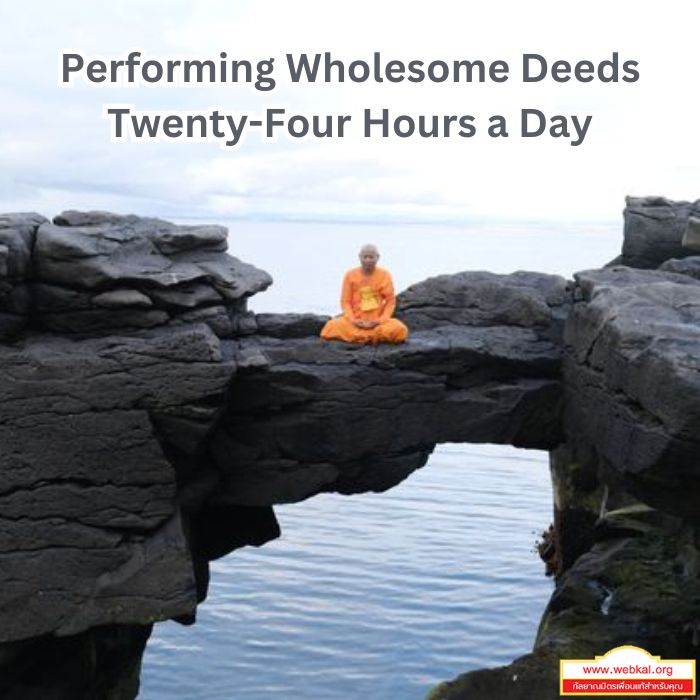September 23, 2546 B.E.

The Rains-Exit Day will be here in eighteen days. Time is passing by so quickly. Every human being is here on earth to make clear the Path and Fruit of Nibbana or at least to pursue Perfections. Every person has the same twenty-four hours a day but the time spent performing wholesome deeds is different with different persons. One needs to check and see if one is spending one’s time effectively when it comes to performing wholesome deeds.
Wholesome deeds can be performed physically through one’s actions, verbally through one’s speech, and mentally through one’s thoughts by adhering to the Tenfold Wholesome Course of Action or at the very least by observing the Five Precepts.The Tenfold Wholesome Course of Action includes three physically wholesome courses of action, namely, no killing, no stealing, no sexual misconduct. It includes four verbally wholesome courses of action, namely, no false speech, no divisive speech, no offensive speech, and no nonsensical speech. It includes three mentally wholesome courses of action, namely, no covetousness, no ill-will, and no Wrong View.
No Wrong View means having Right View. Having Right View means, for example, the view that alms-giving bears fruit, the view that one owes one’s parents a debt of gratitude because they enable one to be born a human for the purpose of pursuing Perfections, the view that the round of rebirth exists, the view that the Hell Realm and the Celestial Realm exist and rebirth in the Hell Realm and the Celestial Realm is real, Enlightened Personages exist, etc. There are altogether ten right views. But just having the view that the Law of Kamma exists, the rest of the right views will naturally follow. In the same token, whoever does not believe in the Law of Kamma can be said to have Wrong View.
Therefore, it is necessary that one adheres to all ten wholesome courses of action on a daily basis. Or one can choose to observe the Five Precepts immaculately. One makes sure that one does not kill, does not steal, does not commit sexual misconduct, does not lie, and does not consume alcohol or other addictive substances. In addition, there are the Six Courses of Ruin which will bring ruin to anyone that engage in these unwholesome activities.
Inconsistency Everyone has the same twenty-four hours a day but the time spent performing wholesome deeds is different with different persons. This Rains-Retreat has been designated as the season for attaining the Dhammakaya. Seventy-two days of it have already gone past and only eighteen days are now left. Whoever has not been able to make any progress in his meditation practice needs to check and see if he has endeavored to practice meditation correctly and every day.
If anyone is being inconsistent in that one was enthusiastic at the beginning of the Rains-Retreat, then as the season went by, one became demotivated, but towards the end one is enthusiastic again, then one must spend the rest of the Rains-Retreat practicing meditation eagerly and correctly too.Stillness Is the Key to Success To attain the Dhammakaya, one’s mind must be brought to a complete standstill. One must stop thinking, stop speaking, and stop doing anything.One simply sits still, yet relaxed and comfortable and then one will see inner images which already exist as the blueprint of life in the center of one’s body. One will see the Pathama Sphere, the Sila Sphere, the Samadhi Sphere, the Panna Sphere, the Vimutti Sphere, and the Vimuttinanadassana Sphere followed by the Refined Human Body, the Coarse and Refined Celestial Bodies, the Coarse and Refined Form Brahma Bodies, the Coarse and Refined Non-Form Brahma Bodies, and eventually the Dhammakaya.
Stillness is the key to attaining the Dhammakaya. It is the stillness characterized by the state of being thought-free, expansive, spacious, light, and comfortable. It is the state which is relaxed, comfortable, and devoid of thought and imagination.Imagination or a visualized image is deployed only at the beginning in order to anchor one’s mind inside the body and prevent it from scattering. Once one’s mind and body become one, that is when one will be able to access all the things that exist inside one’s self. To bring one’s mind back to its original dwelling, in the beginning one has the need
for a visualized image and a mantra.A visualized image can be that of the Buddha or a crystal sphere but the visualization must be carried out correctly. One must not be too intent. One must not stare at the image. Otherwise, one will end up with a headache. One needs to visualize the image easily like visualizing a rose, a lotus, the sun, the moon or the star. If one knows how to correctly visualize an image, one will not end up with a headache. Whether the image is sharp or not, that is a different matter.
It all depends on whether or not one is used to the visualized object.Whatever object one is familiar with, one will have an easier time visualizing it. If one has hardly ever chanted in front of the Buddha Image, one will have a difficult time trying to visualize the Buddha Image. If one is familiar with the object, then the visualized object will be quite sharp. If one is not familiar with the object, then the visualized object will be fuzzy. If one’s mind is free of thought, the visualized object will be very sharp. If one’s mind is filled with thoughts, the visualized object will be very fuzzy.One may also choose not to visualize any image at all if one is confident that one’s mind will not scatter. One can simply keep still but one must not be concerned about seeing darkness or brightness. One is content to simply be with whatever one sees without thinking anything. But most of you end up questioning whatever appears to you instead. Just keep practicing!